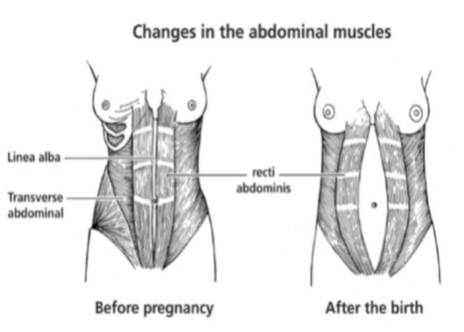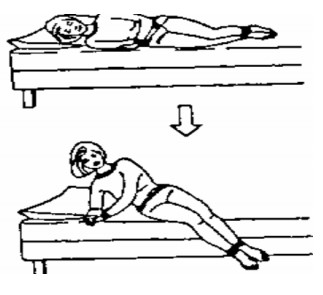Diastasis Recti following pregnancy
Please note, this page is printable by selecting the normal print options on your computer.
This leaflet is to explain what diastasis recti is what can cause it and how to manage it.
What is the rectus abdominis?
The abdomen is composed of four layers of muscle. The rectus abdominis muscle forms the top layer. It runs from the bottom of the ribcage down to the pubic bone of the pelvis. The two halves of the muscle attach together in the middle by connective tissue called the linea alba.
What causes diastasis recti?
During pregnancy, the abdominal (tummy) muscles are stretched with baby’s growth and the linea alba gets softer due to the release of pregnancy hormones. This can cause thinning of the linea alba, resulting in a ‘diastasis recti’.

When will these muscles recover?
Normally a small diastasis recovers within four to eight weeks of pregnancy. However, a larger diastasis may take six to twelve months and requires input from a specialist physiotherapist to prevent long term problems e.g. back pain and incontinence.
Who is most risk?
Some of the risk factors for diastasis recti include:
- Twin pregnancy/larger babies
- Petite women
- Poor posture
- Poor abdominal muscle tone
- Separation in a previous pregnancy
- Obesity/being overweight
- Genetics
- Pregnancies being close together
What to do to look after your back
It is important to protect your weakened muscles. Try to avoid movements that cause a ‘doming’ or ‘bulging’ of the abdomen:
- Avoid sit-ups/ abdominal crunches.
- Avoid heavy lifting and carrying where possible.
- Avoid constipation by eating a healthy diet and good fluid intake.
- Seek treatment for severe / prolonged coughs.
- Take care when getting in/out of bed – contract the stomach muscle prior to starting the movement, roll onto your side and use your arms to assist you, to protect your abdominal muscles.
What happens now?
Your physiotherapist will tailor a personal exercise programme for you, which will be reviewed regularly.
Pelvic floor exercises
- Start by sitting in a comfortable position, feet flat on the floor. Imagine that you are trying to stop yourself passing urine or ‘wind’, by drawing the area ‘upwards and forwards’ from bowel to bladder – then let go. Like a ‘squeezing and lifting’ movement. These exercises are important to begin the strengthening process:
- ‘Squeeze and lift’ and try to hold for a few seconds (breathe normally – don’t hold your breath!). This is a ‘slow hold’.
- Rest for a moment, and then repeat five times if you can. Next, try squeezing the pelvic floor muscles quickly five times, with a little rest between each squeeze. This exercise helps your muscles react quickly when you cough or sneeze.
- Try five ‘slow hold’ squeezes, followed by five ‘quick’ squeezes at least four times a day. As your muscles get stronger, try holding the ‘slow’ holds for longer – aim for 10 slow holds for 10 secs and 10 fast contractions.
Use the NHS approved Squeezy app which is available on all mobile devices.
Remember to change the pre-set programme to the starting programme suggested overleaf.
Other important exercises
- Abdominal muscles exercises
Begin gentle abdominal exercises postnatally when comfortable.
Lying on your side, place your hand on the lower part of your tummy, to feel your muscles working. Gently tighten – hold for three seconds and then relax. Repeat this action 8-10 times, three times a day. - Dynamic Sitting
Whilst sitting, ‘squeeze and lift’ the pelvic floor. At the same time, draw in your lower tummy slightly harder than the exercise above. Hold for five seconds while you breathe out. Relax, and then repeat eight times. Gradually increase the time you hold the muscle for. Your physiotherapist will guide you further with this exercise. - Pelvic Tilts
Sitting or lying on your back with your knees bent up, tighten your pelvic floor and engage your lower tummy. Then flatten your back into the bed and hold for three seconds, then gently release. Repeat five times, keep breathing throughout. When possible, try to reduce how often you are straining your abdominal muscles. Before moving, bend your knees up and draw in the lower part of your tummy a small amount to ‘brace’ it. Reach your arm over in the direction you want to go, at the same time roll your knees over.

To get out of bed, drop your legs over the side and push yourself up into sitting. Standing up, put your hands on the side of the bed, draw in your lower tummy muscles, lean forward and push yourself up into standing. Remember to ‘stand tall’ when you walk.
If possible, avoid pregnancies close together. If this is something you are considering, please mention this to your physiotherapist.
Acknowledgments
www.bootcampmilitaryfitnessinstitute.com
